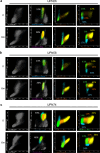Ataluren improves hematopoietic and pancreatic disorders in Shwachman-Diamond syndrome patients: a compassionate program case-series
- PMID: 40897730
- PMCID: PMC12405498
- DOI: 10.1038/s41467-025-63137-3
Ataluren improves hematopoietic and pancreatic disorders in Shwachman-Diamond syndrome patients: a compassionate program case-series
Abstract
Shwachman-Diamond syndrome (SDS) is characterized by exocrine pancreatic insufficiency, neutropenia, and a high risk of myeloid malignancy. Most patients with SDS harbor nonsense mutations in Shwachman-Bodian-Diamond syndrome gene (SBDS), which encodes a ribosome assembly factor. We investigated the translational read-through effect of ataluren in three patients with SDS undergoing a compassionate use program for twelve months. The primary and secondary endpoints were restoring SBDS protein levels in hematopoietic cells and improving myelopoiesis, respectively. SBDS synthesis increased in hematopoietic cells, whereas the bone marrow showed improved cellularity with the maturation of myeloid progenitors. In parallel, absolute neutrophil count was improved in two out of three patients, whereas platelet count increased in all recruited patients. Ataluren treatment normalized mTOR phosphorylation in peripheral blood monocytes and lymphocytes, suggesting a reduction of ribosomal stress. The exocrine pancreatic function also improved. Although the reduced sample size may represent a major limitation of this work, our findings strongly encourages the further clinical development of ataluren to treat SDS.
© 2025. The Author(s).
Conflict of interest statement
Competing interests: V.B. and M.C. are co-inventors of the patent US 11,207,300 B2 “Method of treatment of Shwachman–Diamond syndrome”. All authors declare that they have no additional competing interests. Ethical approval: The research included local and foreign researchers throughout the research process. All clinical data were analyzed by co-authors after de-anonymization of samples, according to pre-defined sharing measures between the involved research groups. Roles and responsibilities were agreed amongst collaborators ahead of the research. This study was approved by the Ethics Committee of the Azienda Ospedaliera Universitaria Integrata, Verona, Italy (approvals No. 4090 and 4182 CESC). Research did not result in stigmatization, incrimination, discrimination or otherwise personal risk to participants. Local and regional research relevant to this study was taken into account in citations. Participants received no compensation for their involvement in this study.
Figures





References
MeSH terms
Substances
Grants and funding
LinkOut - more resources
Full Text Sources
Medical
Miscellaneous

